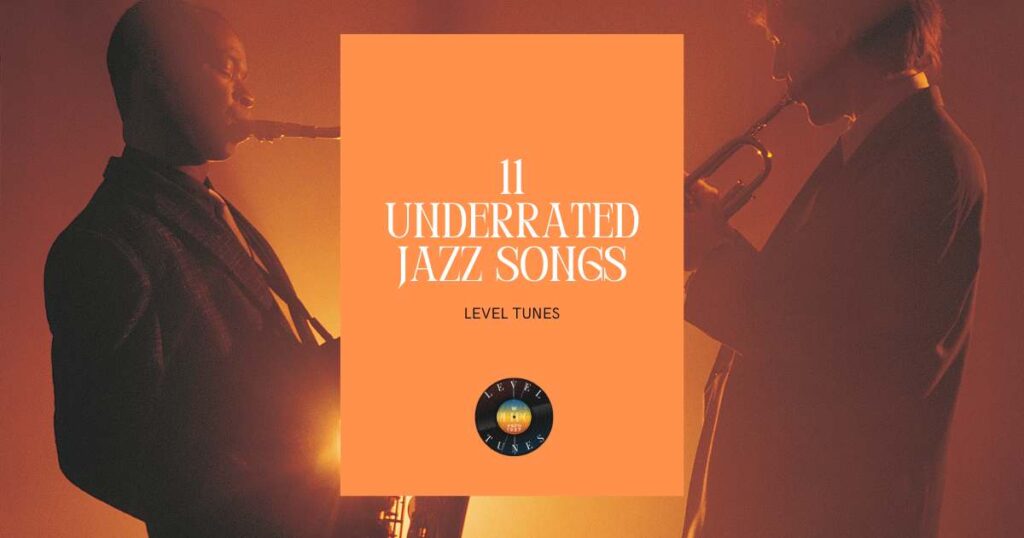11 Underrated Jazz Songs: 11 Jazz Gems
Hey there, fellow music enthusiasts! It’s TBone here, the heart and soul behind Level Tunes.
As a DJ who lives and breathes music, I’ve always been on the lookout for those hidden gems that deserve more spotlight. Jazz, with its rich harmonies and soul-stirring rhythms, holds a special place in my heart. That’s why I’ve decided to put together a list of 11 underrated jazz songs.
These tracks are not just music; they’re stories told through notes and beats. I believe that every jazz tune has its own magic, and it’s high time these lesser-known masterpieces got their moment to shine.
Join me on this musical journey as we explore the depths of jazz, uncovering tracks that have been overlooked but are truly remarkable. Let’s dive into the world of jazz and discover its uncelebrated wonders together!
Here are the underrated Jazz songs that you can check out:
List Of Underrated Jazz Songs
Underrated Jazz songs in a list format:
1. “Peace Piece” by Bill Evans
Album: Everybody Digs Bill Evans (1959, Riverside Records)
“Peace Piece” is an improvisational masterpiece by pianist Bill Evans. Featured on his 1959 album “Everybody Digs Bill Evans,” this track stands out for its tranquil and meditative qualities, a stark contrast to the often energetic and complex rhythms of jazz. Released under Riverside Records, the piece showcases Evans’ innovative approach to harmony and structure. The song, a continuous flow of gentle and lyrical improvisation, has a calming, almost hypnotic effect. Its beauty lies in its simplicity and emotional depth, a testament to Evans’ genius.
2. “Little B’s Poem” by Bobby Hutcherson
Album: Components (1966, Blue Note Records)
Bobby Hutcherson’s “Little B’s Poem,” from the 1966 album “Components” on Blue Note Records, is a vibrant and melodic journey. This track, characterized by Hutcherson’s masterful vibraphone play, shines with a light, airy feel that’s both uplifting and contemplative. The piece is a fine example of Hutcherson’s ability to blend the boundaries between post-bop and avant-garde jazz, creating a sound that’s uniquely his. The song’s intricate yet accessible melody lines make it a standout track, a hidden jewel in the world of jazz vibraphone.
3. “The Sorcerer” by Herbie Hancock
Album: Speak Like a Child (1968, Blue Note Records)
Herbie Hancock’s “The Sorcerer” is a track from his 1968 album “Speak Like a Child,” released under Blue Note Records. This song exemplifies Hancock’s forward-thinking approach to jazz, blending traditional elements with new, experimental ideas. “The Sorcerer” is notable for its complex rhythms and innovative use of harmony, creating an enchanting and somewhat mysterious atmosphere. The album features brilliant performances by a host of talented musicians, including Hancock on piano, helping to bring this magical composition to life.
4. “Isfahan” by Duke Ellington and Billy Strayhorn
Album: Far East Suite (1967, RCA Victor)
“Isfahan” is a mesmerizing track from Duke Ellington and Billy Strayhorn’s “Far East Suite,” released in 1967 by RCA Victor. This song stands out for its exotic, Eastern-inspired melody, beautifully capturing the essence of the Middle Eastern city it’s named after. The lush orchestration and soulful saxophone solo (often attributed to Johnny Hodges) transport the listener to a different world. The track’s seamless blend of jazz and world music elements makes it a unique and unforgettable piece in the jazz canon.
5. “Wildflower” by Wayne Shorter
Album: Speak No Evil (1966, Blue Note Records)
Wayne Shorter’s “Wildflower” from his 1966 album “Speak No Evil,” released on Blue Note Records, is a true work of art. The song features Shorter’s signature saxophone sound, rich in both technical prowess and emotional depth. “Wildflower” is a perfect example of Shorter’s ability to create a narrative through music, with its flowing melody and intricate harmonies painting a vivid picture. The supporting cast of musicians, including Herbie Hancock on piano and Freddie Hubbard on trumpet, add layers of brilliance to this already captivating track.
6. “Cristo Redentor” by Donald Byrd
Album: A New Perspective (1963, Blue Note Records)
Donald Byrd’s “Cristo Redentor” from the 1963 album “A New Perspective” (Blue Note Records) is a soul-stirring piece. This song is notable for its blend of jazz and gospel, featuring a choir that adds a spiritual dimension to Byrd’s trumpet playing. The track is a tribute to the famous statue in Rio de Janeiro, and it captures a sense of awe and reverence. The combination of jazz improvisation with a gospel choir was innovative for its time, making “Cristo Redentor” a groundbreaking and deeply moving piece.
7. “Beatrice” by Sam Rivers
Album: Fuchsia Swing Song (1964, Blue Note Records)
Sam Rivers’ “Beatrice,” from his 1964 album “Fuchsia Swing Song” on Blue Note Records, is a testament to his skill as a tenor saxophonist. The track is a beautiful, melancholic ballad with a haunting melody that stays with you long after the song ends. Rivers’ playing is both tender and powerful, full of emotion and technical finesse. “Beatrice” is a standout piece in Rivers’ discography, showcasing his unique approach to jazz composition and improvisation.
8. “Infant Eyes” by Wayne Shorter
Album: Speak No Evil (1966, Blue Note Records)
Another gem from Wayne Shorter’s “Speak No Evil” (1966, Blue Note Records), “Infant Eyes” is a lyrical and deeply personal composition. Written as a tribute to his daughter, the song features a gentle, lullaby-like melody that is both soothing and expressive. Shorter’s masterful saxophone work, combined with the stellar performances of his bandmates, creates a tender and intimate atmosphere. This track is a beautiful example of how jazz can convey profound emotions and tell personal stories.
9. “Lonely Woman” by Ornette Coleman
Album: The Shape of Jazz to Come (1959, Atlantic Records)
Ornette Coleman’s “Lonely Woman,” from the groundbreaking album “The Shape of Jazz to Come” (1959, Atlantic Records), is a seminal piece in the free jazz movement. The track is notable for its unconventional structure and emotional intensity. Coleman’s alto saxophone, along with Don Cherry’s cornet, creates a haunting and poignant sound that defies traditional jazz conventions. “Lonely Woman” is a bold and innovative track that challenged and expanded the boundaries of jazz.
10. “Naima” by John Coltrane
Album: Giant Steps (1960, Atlantic Records)
John Coltrane’s “Naima,” featured on his 1960 album “Giant Steps” (Atlantic Records), is a sublime ballad. Named after his wife, the song is a profound expression of love and devotion. Coltrane’s tenor saxophone delivers a performance that is both gentle and intense, perfectly capturing the song’s emotional depth. “Naima” is a classic example of Coltrane’s lyrical style and his ability to convey deep feelings through music. It’s a timeless piece that resonates with listeners for its emotional clarity and beauty.
11. “Maiden Voyage” by Herbie Hancock
Album: Maiden Voyage (1965, Blue Note Records)
Herbie Hancock’s “Maiden Voyage,” the title track from his 1965 album on Blue Note Records, is a quintessential jazz composition. The song’s nautical theme is beautifully expressed through Hancock’s innovative use of harmony and rhythm, creating a sense of journey and exploration. The track features some of the era’s finest musicians, including Freddie Hubbard on trumpet and George Coleman on tenor saxophone. “Maiden Voyage” is a masterpiece of modal jazz, showcasing Hancock’s genius as a composer and pianist.
Fun Facts: Underrated Jazz Songs
“Peace Piece” by Bill Evans
- Improvisational Genius: “Peace Piece” was an entirely improvised piece, recorded in one take. This spontaneous creation became one of Evans’ most beloved and influential works, showcasing his exceptional skill in improvisation.
- Influential Legacy: The song has been cited as a significant influence on several generations of pianists and musicians, including contemporary artists in genres beyond jazz.
- Unique Structure: Unlike most jazz pieces, which are based on chord changes, “Peace Piece” is built on a series of gentle, repeated left-hand ostinatos (a motif or phrase that persistently repeats in the same musical voice).
“Little B’s Poem” by Bobby Hutcherson
- Tribute to His Son: This piece was written as a loving tribute to Hutcherson’s son, Barry, who was affectionately nicknamed “Little B.” The song reflects the joy and wonder of childhood.
- Versatile Vibraphone: “Little B’s Poem” is celebrated for its innovative use of the vibraphone, showcasing the instrument’s versatility and melodic potential in jazz.
“The Sorcerer” by Herbie Hancock
- Miles Davis Connection: The title of the song, “The Sorcerer,” is a nod to Hancock’s time with the Miles Davis Quintet, where Davis was sometimes referred to as “The Sorcerer.” The song reflects the creative and experimental spirit that Hancock developed while working with Davis.
- Cinematic Influence: Hancock was known for his interest in film and cinematic techniques, which often influenced his compositions. “The Sorcerer” has a cinematic quality in its arrangement and progression.
“Isfahan” by Duke Ellington and Billy Strayhorn
- World Music Fusion: “Isfahan,” part of the “Far East Suite,” is an excellent example of how Ellington and Strayhorn incorporated world music influences into jazz, particularly Middle Eastern melodies and rhythms.
- Critically Acclaimed: The “Far East Suite,” and by extension “Isfahan,” is often regarded as one of Ellington’s finest late-career works, showcasing his and Strayhorn’s mature compositional skills.
“Cristo Redentor” by Donald Byrd
- Gospel Meets Jazz: This piece is a pioneering fusion of jazz and gospel music, with a choir providing a spiritual backdrop to Byrd’s trumpet. It was an innovative approach at the time and contributed to the development of soul jazz.
- Cultural Icon: The title “Cristo Redentor,” which means “Christ the Redeemer,” refers to the famous statue in Rio de Janeiro, Brazil. The song captures the grandeur and spiritual symbolism of the monument.
“Naima” by John Coltrane
- Love Ballad: Coltrane composed “Naima” for his wife, Juanita Naima Grubbs. It’s a deeply personal piece, reflecting his profound love and admiration for her.
- Covered by Many: “Naima” has become one of Coltrane’s most covered compositions, interpreted by numerous jazz artists over the years, each bringing their own perspective to this beautiful ballad.
“Maiden Voyage” by Herbie Hancock
- Conceptual Album: The entire “Maiden Voyage” album was conceptualized around a nautical theme, with each track representing different aspects of the sea and seafaring. The title track is known for its evocative representation of a ship’s first journey.
- Cross-Genre Appeal: “Maiden Voyage” has been sampled and referenced in various other music genres, including hip-hop, demonstrating its wide-reaching influence beyond jazz.
As we wrap up this musical journey, I hope you’ve enjoyed exploring these 11 underrated jazz gems as much as I did. Remember, there’s always more to discover in the vast universe of jazz. Keep your ears open, and who knows what other treasures you’ll find!
Thanks for reading.
TBone




